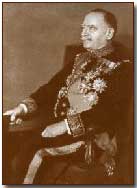Who's Who - Baron Charles de Broqueville
 Baron Charles de
Broqueville (1860-1940) served as Belgian Prime Minister from 1911-1918 and
again from 1932-34.
Baron Charles de
Broqueville (1860-1940) served as Belgian Prime Minister from 1911-1918 and
again from 1932-34.
Born in Postel, Belgium, on 4 December 1860, Broqueville was leader of Belgium's Catholic Party, and Prime Minister in 1911 and again from 1912-18. He oversaw Belgium's mobilisation for war once it became clear that Germany intended to violate Belgian neutrality in August 1914.
Nevertheless de Broqueville opposed King Albert I's proposal to deploy the Belgian Army along the German frontier in Spring 1914, recognising that wartime support for the country depended upon its continued recognition as a non-provocative neutral power. He therefore deployed the army at disperse locations around the nation; a politically sensible move, if a military mistake.
The inevitable German invasion of August 1914 promptly forced the Belgian government into exile at Le Havre. De Broqueville was involved in ongoing disputes with the King over both Belgium's continued stance of neutrality - thereby denying the country a full alliance with the Allies - and the King's wish to consider holding separate peace negotiations with Germany.
Opposing the King on both points de Broqueville's political position was critically weakened once it became clear to the cabinet that he had conducted - without authorisation - peace talks with Austria-Hungary in October 1917. De Broqueville had determined upon his new policy in the wake of ongoing Allied military failures during 1917.
He was consequently obliged to resign as Foreign Secretary in January 1918 - Paul Hymans succeeded him - and as Prime Minister in May when he lost the support of his own party.
De Broqueville nevertheless served as Minister of War from 1926 and was elected premier once again in October 1932 in the Catholic-Liberal coalition, finally retiring in November 1934.
He died on 5 September 1940 in Brussels, aged 79.
French tanks were used for the first time in battle on 17 April 1917, when the 'Char Schneider' (as they were known) was used during the Second Battle of the Aisne.
- Did you know?
